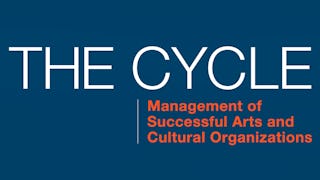Arts and culture leaders have a tough but rewarding task: creating and leading sustainable organizations that deliver real social value. There is a lot of competition out there. Being an effective leader means constantly adapting, cleverly using the best tools to reach as many people as possible. This course is designed to help leaders at any level do just that.

Enjoy unlimited growth with a year of Coursera Plus for $199 (regularly $399). Save now.


(232 reviews)
Skills you'll gain
Details to know

Add to your LinkedIn profile
See how employees at top companies are mastering in-demand skills

There are 5 modules in this course
We welcome you to this five-unit course with a brief history of the world relative to arts and culture and where we are now. What is the substance of value (objective/subjective) – to whom, for what? What are the essential and timeless issues facing us? How do we connect and interlock mission and value to be supportive, contingent and flexible?
What's included
9 videos1 reading1 assignment
How do we deliver on value? This week explores form and function of organizations. By the end of the unit, you will clearly understand organization structures – historic and behavioral biases that keep us from changing current structures, frameworks and logic that build better structures. And you will better understand risk - how best to identify and manage it.
What's included
8 videos2 readings1 peer review
To answer this question we need to understand and evaluate the critical features of our external environment. This will give us context to identify the unique values organizations can bring to communities that build support and allow for stronger collaborations. We will be better able to balance artistic and economic choices, and create differentiation and positioning that attract, serve and keep participants and customers.
What's included
6 videos1 reading1 peer review
A tension exists between artistic/mission and economics. As much as we’d like to try, we can’t be everything to everyone. We must find alignment and balance. How do you recognize and systematically respond to changes in your community? In this unit we’ll explore advancing your mission through a sharp focus on customers and markets; how best to understand the needs and interests of stakeholders; how to identify the best target-customer segments for your organization/project; and how to attract and retain those customers.
What's included
6 videos1 reading1 peer review
Who determines value and how do you influence that determination? In this unit, we look at meaningful measures and meaningful communication. How do you test value? How do you make timely decisions? How do you communicate to the vast variety of stakeholders who support your organization or will support your organization?
What's included
7 videos1 reading1 assignment
Instructors


Explore more from Governance and Society
 Status: Preview
Status: PreviewVanderbilt University
 Status: Preview
Status: PreviewUniversity of Maryland, College Park
 Status: Preview
Status: PreviewUniversità Bocconi
 Status: Free Trial
Status: Free Trial
Why people choose Coursera for their career




Learner reviews
232 reviews
- 5 stars
76.06%
- 4 stars
18.37%
- 3 stars
3.41%
- 2 stars
0%
- 1 star
2.13%
Showing 3 of 232
Reviewed on Jan 2, 2016
A useful course for someone seeking foundational tools for their non-profit
Reviewed on Aug 5, 2020
An excellent course with great presentations and very useful and interesting assignments!Thank you!
Reviewed on Apr 24, 2020
It was my first Coursera course! This particular one is very compact, has plenty of information and tools to use and I highly recommend it!
Frequently asked questions
To access the course materials, assignments and to earn a Certificate, you will need to purchase the Certificate experience when you enroll in a course. You can try a Free Trial instead, or apply for Financial Aid. The course may offer 'Full Course, No Certificate' instead. This option lets you see all course materials, submit required assessments, and get a final grade. This also means that you will not be able to purchase a Certificate experience.
When you purchase a Certificate you get access to all course materials, including graded assignments. Upon completing the course, your electronic Certificate will be added to your Accomplishments page - from there, you can print your Certificate or add it to your LinkedIn profile.
Yes. In select learning programs, you can apply for financial aid or a scholarship if you can’t afford the enrollment fee. If fin aid or scholarship is available for your learning program selection, you’ll find a link to apply on the description page.
More questions
Financial aid available,
¹ Some assignments in this course are AI-graded. For these assignments, your data will be used in accordance with Coursera's Privacy Notice.





